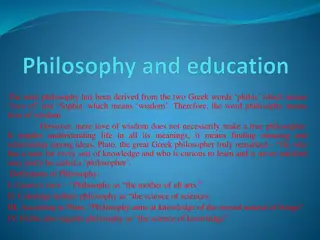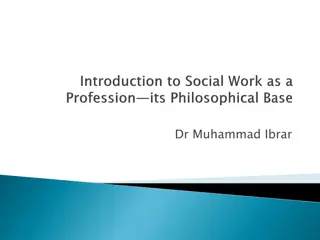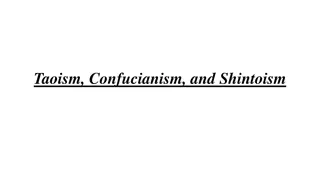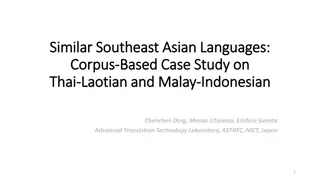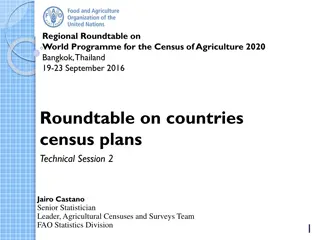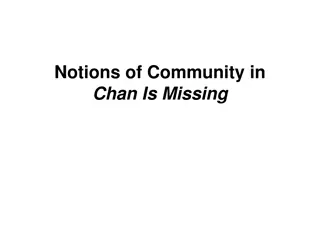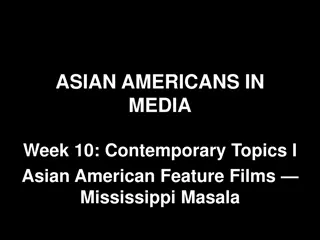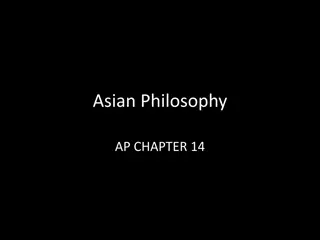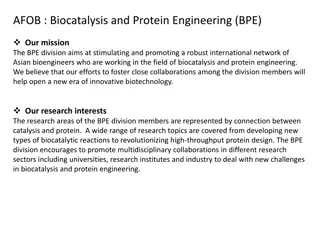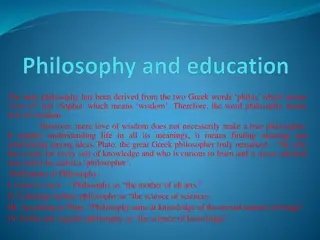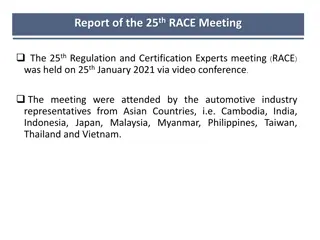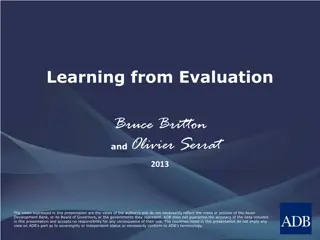Understanding Yin-Yang Philosophy in Asian Culture
Explore the essence of Yin-Yang philosophy with a focus on the Yijing (Book of Changes) and I Ching. Discover how this ancient Chinese philosophy embodies the principles of nature, change, and balance through the interplay of Yin and Yang forces. Delve into the core insights and consulting methods of the I Ching for guidance and reflection on life's complexities. Unravel the concepts of Qi, opposition, and the dualities of dark (Yin) and light (Yang) in the cosmic order of Yin-Yang principles.
Download Presentation

Please find below an Image/Link to download the presentation.
The content on the website is provided AS IS for your information and personal use only. It may not be sold, licensed, or shared on other websites without obtaining consent from the author. Download presentation by click this link. If you encounter any issues during the download, it is possible that the publisher has removed the file from their server.
E N D
Presentation Transcript
Asian Philosophy AP CHAPTER 15
Yin Yang Philosophy Yijing or the Book of changes is China s oldest and most important philosophical text. If the Vedas and Upanishads are India s most revered classical text, then Yijing is clearly China s main work. It is thought originally to be a divination manual for telling the future. it has 64 hexagrams used to tell the future. Each one is constructed out of two tri-grams. A tri-gram is a set of three lines. Eventually, Yijing changed into being the foundational text for cosmology, medicine, architecture, astronomy, and alchemy. Praise for it is offered by Li Guangdi, The merit of the sages in constructing the Classic Changes is equivalent to the creation of all things and the ordering of the world.
Yin Yang Core insight: (i) There are patterns in nature. (ii) By observing the patterns in nature we can come to see that everything is constantly changing. (iii) Everything originates from something. (iv) Everything grows and declines. (v) Everything comes to cease to exist.
I Ching or Book of Changes There are 64 hexagrams. A hexagram represents a unique kind of situation. The 64 diagrams represent 64 distinct situations one can be in. Each hexagram has six lines. Read from bottom to top. Each hexagram is made of two trigrams, each of which have three lines. Each line can either be broken or unbroken. YIN = Broken, Yang = Unbroken
Consulting the I Ching Originally the I-Ching was treated as a divination manual one would consult the I Ching to figure out their current state through the following procedure: (i) Ask a question and keep it in mind. (ii) Take 3 coins toss them 6 times. Tails = 2 pts, Heads = 3pts. (iii) Even totals give rise to a yin line. Odd totals give rise to a yang line. All heads or all tails give rise to a changing line. (iv) Changing lines represent a change from yin to yang or yang to yin. (v) Using a hexagram that is built through this procedure and taking note of changing lines one can read the I-Ching and interpret it for significance about one s current situation.
Yin Yang: Core Model There is a core primordial force QI of which there is both a Yin force and a Yang force.
Yin Yang Yin = Dark Yang = Light
Yin Yang Principles Principle of Opposition Yin and Yang are opposite relative to each other. General Point opposition can be relative. An old man is yang in opposition to a woman. An old man is yin in opposition to a young man. Core Idea what is Yang in one context can be Yin in another, and vice versa.
Yin Yang Principles Principle of Interdependence Yin cannot exist without Yang, and vice versa. General Point there is an interdependence of qualities and things. Principle of Transformation Yin can transform into Yang and Yang can transform into Yin. General Point there is transformation and change.
Constancies in Nature (a) That everything is changing is itself unchanging (b) That Yin and Yang always alternate is unchanging. (c) That one and the same thing always undergoes change in the case of a particular. Although I am born and die, I remain the same person throughout. (d) That the orientation of the universe with the sky above, earth below and everything in between is unchanging. (e) The virtues of earth in so far as it creates, nourishes, and benefits all things is unchanging. (f) Human virtues by which we are supposed to cultivate our character are unchanging. (g) The tendency toward equilibrium is unchanging.
Important Features of Yin Yang Yijing s primary concern is with helping us make good decisions by paying attention to our actual situation and discovering what is really going on with us in the situation. Yijing notices that many things are always changing. Yijing uses correlations and resonances between different realms, such as the cosmos and the self, to understand the effects of changes. Yijing emphasizes the importance of interpretation. Yijing is holistic. Everything originates from the same fundamental energy-stuff qi being formed and transformed by yin and yang.
Important Features of Yin Yang Yijing acknowledges the complementariness of opposites. Yijing recognizes natural harmony. Yijing emphasizes careful observation. Yijing emphasizes the importance of timing. Yijing sees moral goodness as being inherent in the universe, given by the basic energy-stuff (qi).
Yijings Impact on Daoism Consider Laozi Chapter 42 of Daodejing: Dao produced the One. The one produced the two. The two produced the three. The three produced the ten thousand things. The ten thousand things carry the yin and embrace the yang, and through the blending of qi they achieve harmony. Here we get: (i) Everything comes from qi the Dao (ii) By way of alternating movements of yin and yang.
Yijings Impact on Daoism Consider Laozi Chapter 2 of Daodejing: Being and nonbeing produce each other; Difficult and easy complete each other; Long and short contrast each other; Front and back follow each other. Here we get: (i) Everything changing out of the yin and yang in a productive way. (ii) A cooperative relation exists between opposites.
Yijings Impact on Daoism Consider Laozi Chapter 77 of Daodejing: Heaven s Way is indeed like the bending of a bow. When (the string) is high, bring it down. When it is low, raise it up. When it is excessive, reduce it. The Way of Heaven reduces whatever is excessive and Supplements whatever is insufficient. Here we get: (i) (ii) Balance and Harmony That Heaven can reduce what is in excess
Yijings Impact on Confucianism The impact on Confucianism is clear since the Ten Commentaries on the classic text are basically Confucian. Confucius accepted the Yijing idea that true values, including important virtues, have their basis in nature itself. Confucius changed how Yijing was studied. First it was studied in order to understand nature. Confucius used it to study wisdom and virtue. Yijing becomes about how to develop virtue rather than how to predict good or bad fortune in the hands of Confucius.
Confucius on Yijing Regarding use of the Yi text, I put aside the divinations. I observe what concerns virtue and righteousness in them. If posterity criticize me, perhaps the cause will be my view on the Yi? I merely seek virtues in them. One may say that I and shamans and historians share the same route but reach different goals. A superior man seeks happiness in his virtuous conduct, therefore he would not offer many sacrifices. A superior man seeks good in his practice of ren and yi, therefore he does not engage in many divinations. Did I therefore put divinations on a secondary level?





